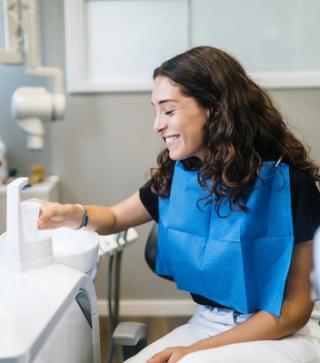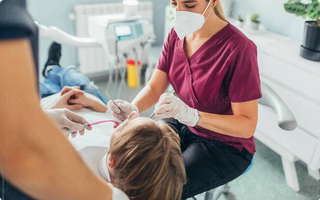Richmond Dental Hygiene
Ensure your oral health with a routine check-up to maintain a healthy, happy smile.

With Richmond's dental hygiene program, Melbourne have the program that you can trust for professional and high-quality teeth cleaning.
Your dental hygiene appointment
All patients coming to our dental clinic for a teeth cleaning appointment will now receive a more in-depth clean. Our practice has acquired an Airflow GBT tool, This Swiss-engineered tool, called Guided Biofilm Therapy, allows our dental hygienist to identify more plaque deposits accurately and remove them using air.
Compared to a traditional tooth clean using manual dental scrapers, the EMS Airflow GBT tool is:
- quicker, taking about half the time needed for a conventional clean
- more efficient, identifying more plaque deposits
- affordable, with no extra cost to patients for the use of this equipment.
Dental hygienist tips on effective brushing
Our dental hygienist recommends you select a soft-bristled toothbrush with a small head so you can access hard to reach places including your back teeth. This avoids your tooth enamel being damaged by scrubbing with a hard brush. At Richmond Fine Dentistry we have a selection of toothbrushes for your convenience.
Brushing
You should brush your teeth for at least two minutes twice a day. Our dental hygienist recommends this for teeth cleaning, fresh breath and contributes to the prevention of gum disease. Effective brushing technique is vital.
Advice on interdental cleaning
Effective teeth cleaning comprises two parts: brushing and interdental cleaning, or cleaning between the teeth. 60% of the clean happens because of brushing: the other 40% of the clean is due to interdental cleaning. Our dental hygienist recommends regular interdental cleaning, especially before bed, as an essential part of your oral care routine. It will remove plaque build-up and food particles between your teeth where the tooth brush can’t access.
When flossing, be careful to avoid injuring your gums.

How to floss effectively?
- Using approximately 50cm of floss, wind it loosely around your middle fingers and hold the floss with thumbs and index fingers so you have about 1 cm of floss. Carefully insert the floss between two teeth using a back and forward sawing action. Curve the floss around the side of your tooth to make a curved ‘C’ shape. Slide the floss up and down the side of each tooth. Gently push the floss under the gums as far as it can go whilst the floss is curved around the root of the tooth. Do not force the floss below the gums. Floss until you get a nice squeaky clean feeling.
- Our dental hygienist says: remember each space has two surfaces to clean!
- Use a clean length of floss of approximately 7 centimetres for each tooth, repeat the process for all your teeth. Don’t forget to floss the back and sides of your back teeth. Although it can take some time to master, it’s an important part of your daily oral hygiene routine.
- Children’s teeth also benefit from flossing. You should help your child brush and floss until they are around 8 years old as younger children are not able to do this effectively on their own.
- Interdental brushes are now a popular and often favoured way of cleaning between the teeth. No more ‘flossers finger’! Tooth paste can be used to enhance cleaning and deliver fluoride and other beneficial agents like Triclosan found in Colgate Total to the interdental tooth surfaces.
- Come into Richmond Fine Dentistry: we have a full range of interdental brushes. We would be happy to advise you on correct size of brush for you and brush technique.

How do I clean surfaces where there are large gaps or teeth missing?
You can use your floss or even a small toothbrush, but the ‘shoe shine technique’ is ideal.
Shoe Shine technique
Buy some 2in x 2in (5cm x 5cm) gauze. Pull gauze at corners to create a long thick ‘floss’ and use to polish the surfaces of the teeth facing onto the gaps and the very back surfaces. Toothpaste can be applied to gauze and use in a shoe-shine, back and forth motion, a bit like drying your back with a towel. This is a great tip for partial denture wearers.
Toothbrush hygiene
Have you ever wondered about the wisdom of brushing your teeth with a dirty, unhygienic toothbrush, that contains millions of bacteria? Some research suggests that toothbrushes are a hidden source of infective material that recontaminate the mouth and causing illness.
And the effects of tooth and gum infection are not confined to the mouth. Links have been established between periodontal disease, stroke and coronary artery disease, and recent studies indicate a connection between gum disease and higher instances of pre-term delivery and low birth-weight babies. The precise nature of these correlation has yet to be determined, but at this stage we can accept that a healthy mouth is a prerequiste for a healthy body.
Contact us today for more information or to book an appointment for your dental hygienist, Melbourne.
EMS Airflow GBT (Guided Biofilm Therapy): advanced teeth cleaning technology
When you come to our dental clinic for teeth cleaning with our experienced dental hygienist, we’ll offer GBT (Guided Biofilm Therapy) as our standard dental cleaning approach. Our refreshed dental hygiene method uses Swiss-engineered instruments which provide a better result than traditional teeth cleaning procedures which use scrapers and abrasive pastes.
We use the EMS Airflow Prophylaxis Master tool to perform GBT. It allows for quieter, less abrasive and more detailed plaque removal. In addition, the air-based nature of the tool results in a higher level of dental hygiene because of the more intensive clean it provides.
The time taken for a thorough dental clean is halved compared to the time it takes for a clean using traditional methods. This means our dental professionals have extra time to focus on all aspects of your oral health.
Frequently asked questions
Most people should have a dental check-up twice per year. This is in order for your dentist to keep an eye on your dental health, prevent issues from occurring, and treat any problems that arise immediately.
If you are having issues such as dental pain and wish to be seen sooner, don’t hesitate to make a booking with your dentist as soon as possible.
In Australia, the cost of a regular dental check-up will vary based on a number of factors.
Typically, a check-up will include an oral exam, x-rays, and cleaning from a dental hygienist. Your appointment may cost more if you require additional services, or less if you don’t need all of the above.
Most private health insurance companies will provide some level of rebate for dental check-ups, as they are considered preventative treatments. Check with your health fund provider, as you may be entitled to at least one gap-free check-up per year.
Your first dental check-up will typically be 45 minutes to an hour, as this includes your dentist taking a set of x-rays, doing an oral exam, and a professional clean.
A check-up with your regular dentist will typically be 30-45 minutes.
No, your dental cleaning should not be painful.
During the cleaning, your practitioner will floss and polish your teeth, and use a descaler to remove any built-up plaque. While some of these steps may feel a little uncomfortable, you can ask to pause at any time.
If you do experience pain during cleaning, let your dentist know, and they can investigate the issue.
Yes, definitely. In fact, it is recommended to have a dental check-up during pregnancy, as pregnancy hormones can have an effect on your oral health. This can lead to issues such as inflammation of the gums and gingivitis. It is especially important to have a check-up if your pregnancy is causing you to vomit regularly, as this can damage your teeth.
Let your dentist know that you are pregnant so they can keep an eye out for these issues and offer advice for looking after your oral health during this time.
To prepare for your dental appointment, brush and floss your teeth before visiting your dentist. You should also think about whether you have any questions for your dentist regarding your oral health, and be prepared to let them know if you have any issues you’d like to discuss, such as dental pain.
During your regular dental check-up, your dentist will scrape off any plaque that has built up on your teeth. This sticky substance is made from bacteria and forms on your teeth constantly, which is why it’s important to brush and floss daily to remove it. However, plaque often ends up building up, especially in places that are difficult to reach with your brush.
Plaque is the cause of numerous dental issues, including teeth discolouration, bad breath, and gum disease. If untreated, it can even lead to periodontitis, which can result in the loss of teeth.
Once plaque builds up, it is too stubborn to remove with a regular toothbrush, which is why a dentist will scrape it off during your check-up. This helps to keep your teeth and gums as healthy as possible.
Your dentist will also offer advice on how to avoid plaque from accumulating in between appointments.

